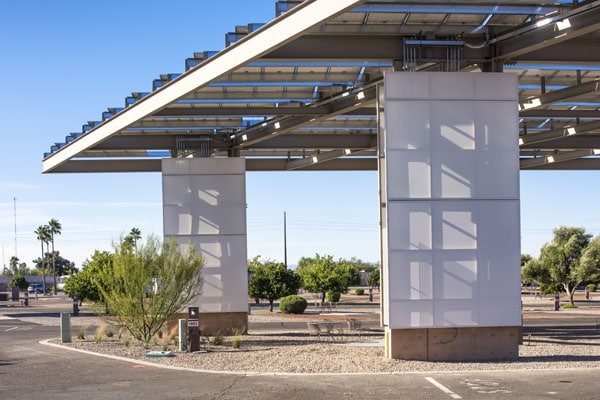When the temperature climbs into the triple digits in Tucson, locals and visitors alike seek the same thing: shade. It’s essential in a city with some 350 days of sunshine a year. Two new installations at the Tucson/Lazydays KOA campground harness the potential of that blazing sunlight and simultaneously create some two acres of shade—all while preserving views of the mountains and desert beyond.
Known as PowerParasols, the soaring structures contain 3,500 solar panels that generate 80% of the campground’s total electricity needs. The RVs that park underneath benefit from dappled sunlight, but because the solar canopy soars high above them, campers can still camp, gather and even barbecue at the site. And enough sunlight comes through to also ensure that the campground’s famous orange, grapefruit, and lemon trees thrive.

Known as PowerParasols, these soaring structures contain 3,500 solar panels, which generate 80% of this campground’s total electricity needs. PHOTO: MIKE NOTHUM COURTESY OF STRATEGIC SOLAR ENERGY
It’s the first solar shade project to be developed in a campground, according to Chandler, Arizona-based Strategic Solar Energy. The company, which recently patented its design, has also installed its PowerParasols at Arizona State University and Fry’s Food Stores over the past five years.
The KOA installations, implemented with the help of general contractor Robert E. Porter, are expected to generate an impressive 1.75 million kilowatt hours of energy in 2016. But the project was never aimed at energy generation alone. As Bob Boscamp, president of Strategic Solar Energy, describes the PowerParasol: “It’s a very elegant shade structure that happens to deliver a lot of energy.”

Creating a timeless piece of architecture was essential to Jack DeBartolo, the lead design architect. “Especially on these very large outdoor projects,” he says, “we have to make sure we are sensitive to surrounding context,” from the mountains to the prevailing breezes. Placemaking is both his responsibility and his passion. Architecture, whether it’s a shade structure or a building, is all about “raising people’s awareness of place,” according to DeBartolo.
Each PowerParasol is custom-designed to meet the specific needs of its location—a rigorous process. In this case, the team overcame several challenges, according to Mike Nothum, COO of Strategic Solar Energy. There was the engineering obstacle presented by the sheer length of the structures—each of the two is 558 feet, which is longer than a football field. Then there’s the shape itself. Large RVs can’t pull into a parking space at a 90-degree angle, nor can they safely navigate around an obstacle course of support beams. Instead of a traditional right-angle structure, the team eventually settled on a parallelogram, with as few beams between the drive aisles as possible.
The electricity generation itself spurred another key innovation. The solar inverters—which transform the solar electricity from direct current (DC) to alternating current (AC)—are typically bulky structures the size of a truck, Nothum says. The team opted instead for 32 smaller inverters distributed throughout the two PowerParasols. Installed within the vertical brace frames, they virtually disappear. They can be easily accessed when necessary, but otherwise you wouldn’t know they’re there.
The PowerParasols create shade and send campers a strong message about KOA’s commitment to sustainable energy. But they also boost the bottom line, according to KOA president Pat Hittmeier. Over the next 25 years, he expects a 6% return on investment from the project. In other words; it makes sense both environmentally and financially. Looking to the future, that dual benefit will be especially critical for solar projects to be viable. With the eventual end of tax credits, solar has to pull its own weight.

The solar inverters, which transform the electricity, are hidden in this project (they’re typically bulky). PHOTO: MIKE NOTHUM COURTESY OF STRATEGIC SOLAR ENERGY
“As the market matures and incentives and rebates start to decline or are removed, you have to have some other value proposition to make the economics work on solar,” Boscamp says.
For visitors to the campground, the main draw isn’t the ROI or even the sustainability of the PowerParasols. It’s the shade—and the striking design. For a steel canopy soaring 28 feet into the air, it’s surprisingly light and airy, Nothum says. “You feel the presence of the structure, but you almost don’t see it,” he says.
PowerParasol is a registered trademark of Strategic Solar Energy.
![]()


